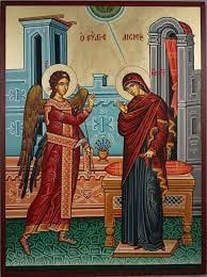 he Feast of the Incarnation is perhaps the most significant Feast of the Church. Without this beginning the would be nothing, without Mary, no Incarnation. Our language may seem extravagant and our frequent references to Mary in our prayers may seem excessive, but both mark the immense importance of Mary in the life of the Church. Recently, a member of the Baptist Church remarked to his friend, ‘we have not paid enough attention to the role of Mary’. We in Orthodoxy have. God’s overflowing with love and goodness created mankind as the true image of Himself, He made man and woman in the image of God and let them share His sovereignty, His overall care of Creation. Only men and women in the whole of creation are made in the image of God. Sadly this sovereignty had been disfigured and diminished and had to be restored, but how? Here was God’s plan. In order to restore man and woman and creation to it’s original beauty, the Creator Himself, God Himself had to become incarnate, take on our nature in it’s fullness. The only way was to have young maiden, a virgin who could take on this role. Nicholas Cabasilas in his sermon for the Annunciation describes how God was overjoyed when He was aware that such a woman existed and because of her purity, her devotion, her perfection, He, God, could not wait longer for His plan of action to be put in place. The incarnation was now possible. Mary retained the innocence and purity of childhood and continued to be so close to God in her prayerfulness without distraction. She was always aware that she was in God’s presence and, indeed, she had become His handmaiden. ’Behold the handmaid of the Lord’ spilled instantly from her lips when challenged by the Angel Gabriel when he visited her. ‘Blessed is the fruit of your womb, O all pure one,’ was His reply." And so we in turn exclaim. "O Virgin Mary, the light of God dawned from your womb, spreading over the whole earth, the light of God’s threefold nature. Through you, O pure virgin, through God’s rays, earth became another heaven" "Praise the Lord, all you His works; exalt Him above all for ever." Our Lord born of Mary, took his flesh from her - Mother like son. His disciples must have seen her in him and him in her. Incarnation means that everything of the mother is passed into the child, not only physically, but emotionally, mentally and spiritually. All this arises at birth, a potential to be developed in loving care and upbringing. Mary’s emotions, love , care, devotion were there to bring up her son. Her personality and devotion to God, were there to guide. Her spirituality and prayer poured into him. She gave him his full humanity. "Blessed indeed is the fruit of your womb and blessed are you who formed him and nurtured him into the fullness of the image of God. By your purity and closeness to God he was fully enabled for his life ahead." Yes, he was God, but it was Mary who gave him his human nature and ensured that by giving birth to him and nurture of him, he became the full, undistorted image of God in man. One of the most beautiful hymns is to be found in the First Hour, said daily: "What shall we call thee, O thou who art full of grace? Heaven, for thou hast caused the Sun of Righteousness to rise? Paradise, for thou has blossomed forth the Flower of Immortality? Virgin, for thou hast remained without corruption (sin)? Pure Mother, for thou hast held in thy holy embrace a Son, who is God of all? Beseech thou him to save our souls." The Troparion of the Feast marks its significance for us: "Today is the beginning of our salvation and the revelation of the Mystery that was planned from all eternity. The Son of God becomes the Son of the Virgin, and Gabriel announces this grace. Let us join him in crying out to the Mother of God: “Hail, O full of grace, the Lord is with you!” Fr David
2 Comments
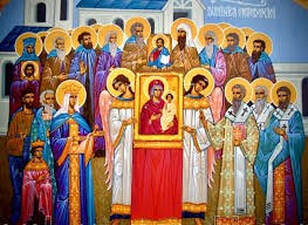 On this day we celebrate the return of Icons into our life in the Church. They were lost and now they are found, they were ‘dead’ to our awareness but now they are ‘alive’ and fill us with their life. We are immediately led to recall the Parable of the Prodigal Son, three Sundays before Great Lent. We could not be together this year in our reduced, ‘lost’ state, but perhaps it is worth considering in our celebration of Orthodoxy, a celebration of restoration. In the parable, the younger brother, restless in the confines of the home where he had been born and brought up, seeks to explore the world and demands the wherewithal to do this. His Father, out of unconditional love, allows him to go and gives him a good endowment. The young man goes off to a far country and wastes his life in prodigality, this simply means recklessly wasteful, and we should not accept the older brothers’ thoughts without consideration. The Publican, the Pharisee and now the Prodigal are chosen to remind us of aspects of ourselves, and our lives past, as we stand before God in Great Lent. The central theme of the story is not prodigality but restoration and a new beginning. The younger brother, the parable explains, ‘came to himself’, realised what a mistake he had made, and so returned to his father’s house and his Father, ‘seeing him afar off’ runs out to meet him, to welcome him back, to put upon him a robe (of righteousness), a ring on his finger (the signet of reintroduction to the family), and sandals on his feet (of the Gospel of Peace). My son ‘was dead and is alive again and was lost and is found.’ With the rediscovered icons, found and ‘alive’ again, we too, in Great Lent are found again and made alive again. Fasting, almsgiving and prayer helps us to return to our Heavenly Father, to have our robe, ring and shoes restored in this wonderful season. It is a season of repentance, turning again, and a season of Great Joy. Perhaps more than ever this year, as lockdown is eased, we are not only fully restored and welcomed into the home of our Heavenly Father, however much we have been prodigal during the past year, but we are also able to gather again as members together of His loving family. Restored, as were the Holy Icons, we go forward into the Restoring Grace of Great Lent. May God bless us and guide us. Fr David The 20 March is the day of St Cuthbert, and here is a short film about his life: https://www.youtube.com/watch?v=DFG2rgxfra8&t=3s The painting of St Cuthbert during prayer is made by the Orthodox brotherhood on the Isle of Mull.
st theodore of tyro and sunday of orthodoxy 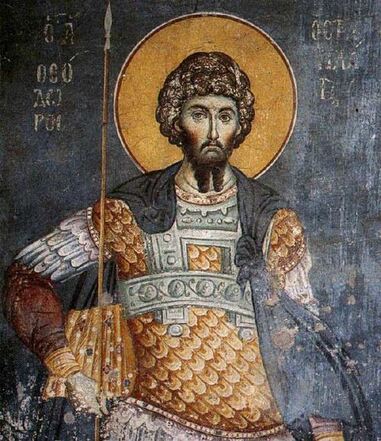 ST THEODORE OF TYRO - THE RECRUIT Each year on the first Saturday of Great Lent, our Holy Church commemorates St Theodore the Recruit. According to the time-honoured tradition, this feast is dedicated to St Theodore of Tyro, known as St Theodore the Recruit, and to his miraculous appearance to Eudoxius, archbishop of Constantinople, during the reign of emperor Julian the Apostate (332-363). The story involving this miracle is well known. Emperor Julian was called the Apostate because during his rule as Caesar (355-361) and then Augustus (361-363) he attempted to restore the pagan cults and to eradicate Christianity. To fulfill this aim, he enacted a range of legal measures, including the persecution of Christians. The Emperor was known for his mocking attitude towards Christianity, which is clearly evident in the few written works of his that have been preserved — most notably in his satires "The Caesars" and "Misopogon," as well as in the remaining fragments of "Against the Galileans." By "Galileans" he means the Christians. Christ Himself he mockingly called "the Galilean," and the Christian churches "ossuaries," due to their possession of Holy Relics. As part of his campaign against the Christians, during Great Lent he decided to mock them by secretly commanding that all Lenten food at the market was to be sprinkled with blood from pagan-sacrificed animals. His aim was to then announce all Christians as pagans, regardless of the fact that they had eaten these foods without knowing of his deed. Through God's gracious providence, however, says the agiographer, St Theodore sensed this plan. He warned Eudoxius, the archbishop of Constantinople, who took action, as a result of which the Emperor's plan failed. In remembrance of this event and in thanks to God's intervention through St Theodore, the Church has ordained that on the first Saturday of Great Lent the miracle performed by the Saint is to be commemorated. The Christians bless specially cooked wheat - “kolivo” - in commemoration of the “miracle with the kolivo”: in order to prevent Christians from eating food which was sprinkled with idolatry blood, St Theodore told the archbishop to tell all Christians to eat boiled wheat with honey for a week. Apart from this, the memory of St Theodore is celebrated on the 17th of February, on the day of his martyrdom. St Theodore was a Roman soldier who was imprisoned - hence the name "the Recruit" - after being accused for arson attack on a Roman temple, and martyred after he confessed his Christian faith by being thrown into fire. www.oca.org/saints/lives/2021/02/17/100547-greatmartyr-theodore-the-tyro-the-recruit The Saturday of St Theodore was established as a feast by the holy Empress Theodora II (842-856). It was ordained that it was to be celebrated directly before the Sunday of Orthodoxy, so as to also commemorate the deed of the Empress, who was the wife of the iconoclast emperor Theophilus and the mother of Emperor Michael III, thanks to whom the icon-worship was restored. Not coincidentally is the Sunday of Orthodoxy celebrated the next day: a commemoration of all those who have fought for the sanctity and fullness of Orthodoxy.” Written by Ventzislav Karavaltchev Translated into English by Daniil Gerov sunday of orthodoxy 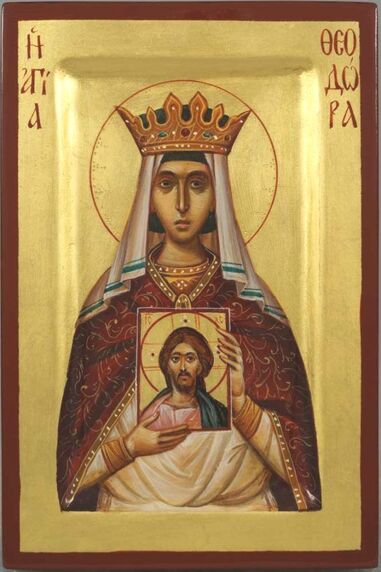 "Let us clap our hands for joy seeing this great blessing that we have received, how the divided members of Christ have been brought to unity! Let us praise the God Who has bestowed peace upon us! - Today the Church is given the festival of victory through the divinely-inspired order and will of our gracious emperors Michael and Theodora who in piety uphold the true Faith. - The sword of heresies has failed and we experience a holy joy, O spotless Virgin, as we see your whole Temple reverently adorned with the holy icons. - Let the mystical trumpets of Christ's Apostles sound forth in harmony, proclaiming the restoration of the holy icons. - Depicting Thy divine form in the icons, O Christ, we openly sing of Thy Nativity, Thine ineffable miracles and Thine voluntary Crucifixion. - The icons of the prophets, apostles and martyrs, the images of all the saints, adorn the heavenly Jerusalem which shines with spiritual beauty of the Bridegroom and the unwedded Bride." (From the Canon and the Sessional hymns of the Sunday of Orthodoxy - the First Sunday of Great Lent) Edited and compiled by Vera Davidova-Pote CATECHETICAL HOMILY
AT THE OPENING OF HOLY AND GREAT LENT + BARTHOLOMEW BY GOD’S MERCY ARCHBISHOP OF CONSTANTINOPLE-NEW ROME AND ECUMENICAL PATRIARCH TO THE PLENITUDE OF THE CHURCH, MAY THE GRACE AND PEACE OF OUR LORD AND SAVIOR JESUS CHRIST, TOGETHER WITH OUR PRAYER, BLESSING AND FORGIVENESS BE WITH YOU ALL * * * Most honorable brothers and blessed children in the Lord, With the good-will and grace of God, the giver of all good things, we are entering Holy and Great Lent, the arena of ascetic struggles. The Church knows the labyrinths of the human soul and the thread of Ariadne, the way out of all impasse – humility, repentance, the power of prayer and the sacred services of contrition, fasting that eliminates the passions, patience, obedience to the rule of piety. And so the Church invites us once again this year to a divinely inspired journey, whose measure is the Cross and whose horizon is the Resurrection of Christ. The veneration of the Cross in the middle of Holy and Great Lent reveals the meaning of this whole period. The word of our Lord echoes strikingly: “Whoever desires to follow me … let them lift their cross each day and follow me” (Lk 9.23). We are called to lift our own cross, following the Lord and beholding His life-giving Cross, with the awareness that the Lord is the one that saves and not the lifting of our cross. The Cross of the Lord is “the judgment of our criteria,” “the judgment of the world,” and at the same time the promise that evil in all its forms does not have the final word in history. In looking to Christ and under His protection, as the One who permits our struggle, while blessing and strengthening our effort, we fight the good fight, “afflicted in every way, but not crushed; perplexed, but not driven to despair; persecuted, but not forsaken; struck down, but not destroyed” (2 Cor 4.8–9). This is the experiential quintessence also during the present period of the Cross and the Resurrection. We are on a journey to the Resurrection through the Cross, through which “joy has come to the whole world.” Some of you may wonder why the Church, in the midst of the current pandemic, would add to the already existing health restrictions yet another “quarantine,” namely Great Lent. Indeed, Great Lent is also a “quarantine,” a period that lasts forty days. Nevertheless, the Church does not aim to weaken us further with additional obligations and prohibitions. On the contrary, it calls us to give meaning to the quarantine that we are living as a result of the coronavirus, through Great Lent, as liberation from enslavement to “the things of our world.” Today’s Gospel reading establishes the conditions of this liberation. The first condition is fasting, not in the sense of abstaining only from specific foods, but also from those habits that keep us attached to the world. Such abstinence does not comprise an expression of contempt of the world, but a necessary precondition for reorienting our relationship with the world and for experiencing the unique joy of discovering the world as the domain of Christian witness. This is why, even during this stage of fasting, the approach and experience of the life of the faithful have a paschal dimension, the taste of the Resurrection. The “Lenten atmosphere” is not depressing, but joyous. It is the “great joy” that was proclaimed as good news by the angel “to all people” at the birth of the Savior (Lk 2.10). This is the unwavering “fulness of joy” (1 Jn 1.4) of life in Christ. Christ is always present in our life – He is closer to us than we are to ourselves – all the days of our life, “unto the end of the ages” (Mt 28.20). The life of the Church is an unshakeable witness to the grace that has come and to the hope of the Kingdom, to the fullness of revelation of the mystery of the Divine Economy. Faith is the response to God’s loving condescension to us; it is the “Yes” of our whole existence to Him, who “bowed the heavens and descended” in order to redeem the human race “from the slavery of the enemy” and in order to open for us the way toward deification through grace. The sacrificial love for the neighbor and the “care” for the whole creation spring from and are nurtured by this gift of grace. If this charitable love for others and the god-pleasing concern for creation are absent, then my neighbor becomes “my hell” and creation is abandoned to irrational forces, which transform it into an object of exploitation and into a hostile environment for humankind. The second condition of the liberation promised by Great Lent is forgiveness. Oblivion of divine mercy and God’s ineffable beneficence, breach of the Lord’s commandment that we should become “the salt of the earth” and “the light of the world” (Mt 5.13-14), and a false transformation of the Christian way of life: to all of these attitudes leads a “closed spirituality” that thrives on the denial and rejection of the “other” and of the world, wipes out love, forgiveness and the acceptance of the different. Yet, this barren and arrogant attitude of life is denounced emphatically by the word of the Gospel on the first three Sundays of the Triodion. It is known that such extremes are especially prevalent during periods when the Church invites its faithful to spiritual discipline and vigilance. However, the authentic spiritual life is a way of internal renewal, an exodus from our selves, a loving movement toward our neighbor. It is not based on syndromes of purity and exclusion, but on forgiveness and discernment, doxology and thanksgiving, according to the experiential wisdom of the ascetic tradition: “It is not food, but gluttony that is evil … not speaking, but idle speech … not the world, but the passions.” With this attitude and these sentiments, we join our prayers with all of you, beloved brothers and children, that we may definitively overcome the lethal pandemic and swiftly respond to its social and economic consequences. And we ask for your beseeching supplications, too, for the reopening of the Sacred Theological School of Halki, after a long period of fifty years that has passed since its silence was imposed externally and fully unjustly, as we welcome Holy and Great Lent in the Church, singing and chanting together “God is with us,” to Whom belongs the glory and might to the endless ages. Amen! Holy and Great Lent 2021 BARTHOLOMEW of Constantinople Fervent supplicant for all before God ------------------- This is a photograph of a planter in our garden. Every time I look at it, I see the eye of an elephant looking at me! What about the car on the right? I bet you see a smiley face. This tendency for the incorrect perception of a stimulus as an object, pattern or meaning is known as Pareidolia. This ability can be great fun and can be helpful in developing our imagination and creativity. However, as with most things there can be dangers associated with it too! This is not too dissimilar to reading the Holy Scriptures. One needs only to scan some of the contemporary popular ‘Spiritual/Christian’ books to see how incorrect perceptions and understandings abound. In our Gospel reading for this Sunday we read our Lord’s parable of the Last Judgment. When Christ will come and judge us. When “All the nations will be gathered before Him, and He will separate them one from another, as a shepherd divides his sheep from the goats. And He will set the sheep on His right hand, but the goats on the left” (Mat 25v32-33), and how “…He will also say to those on the left hand, ‘Depart from Me, you cursed, into the everlasting fire prepared for the devil and his angels” (v42). These verses can leave us anxious and fearful; they can leave us with the image of a God who judges with a strong belief in retribution and punishment. Equally we can read how “Come, you blessed of My Father, inherit the kingdom prepared for you from the foundation of the world: for I was hungry, and you gave Me food; I was thirsty, and you gave Me drink; I was a stranger, and you took Me in; I was naked, and you clothed Me; I was sick, and you visited Me; I was in prison and you came to Me.” These verses may lead us to think that what God requires of us is social activism. A God who is not so interested in the person but rather the ‘common good’. These thoughts and impressions may have a degree of validity, but if this is all we see then we are missing the point of the parable. This parable is about Christian love – no more, no less. Love of God and love of neighbour. We each have a responsibility to love. It may not be possible to perform great humanitarian acts, to feed or provide drink for the hungry and parched of this world, to house the homeless and destitute, or to visit the sick or those who are incarcerated. But we can all take responsibility for sharing the love we have in Christ with those who share that small part of Gods kingdom for which we have been made accountable. Remembering “… inasmuch as you did it to one of the least of these My brethren, you did it to Me.’ (v40) As we begin our preparations for the Great Fast, we need also to ensure that our perceptions and understanding of what is required of us as we fast are correct. The Christian life is essentially directed toward three focal points – God, our neighbour, and our soul. Through prayer we orientate ourselves toward God; almsgiving turns our attention toward neighbour and fasting toward self. There are few references to fasting in the New Testament, not because it can be ignored but because it is assumed; ‘Moreover, when you fast,…’ (v40), not ‘If’ but ‘When’! For most, a fast is an extended period of time when one eats nothing. And for the early Church this was what fasting was. However, for us, the practice is (with welcome modifications) a vegan diet with crustaceans permitted. It is not something to be undertaken to show one’s piety, “Moreover, when you fast, do not be like the hypocrites, with a sad countenance. For they disfigure their faces that they may appear to men to be fasting…when you fast, anoint your head and wash your face, so that you do not appear to men to be fasting.” (Mat 6: 16-18). Like prayer and almsgiving, fasting is, in a literal sense, practical; it is something we do; Jesus expects it and the church requires it. Because, as Fr Thomas Hopko teaches us ‘The effort enlightens the mind, strengthens the spirit, controls the emotions and tames the passions. And so, as we prepare and continue on our journey to Pascha let us stand with Blind Bartimaeus and say “Lord, that I may receive my sight.” (Mark 10 v51). Let us be sure about what we are looking at. Let us not be deceived or misled by incorrect perceptions or understandings. Let us not live in fear judgement and retribution but rejoice in the God who is love. Let us not focus on what we are giving up but rejoice in what we are gaining. Father Julian  "“Let us not be taken prisoner by our eyes; let not our tongue delight in costly food, for once they have been eaten they are worthless; let us shun all greed, then we shall not become slaves to the passions which follow an excess of food and drink (Triodion) |
Parish Blog
This mainly contains homilies and messages from our priests, although there is some scope to share thoughts and interesting articles which we may want to share with others Archives
October 2022
Categories |
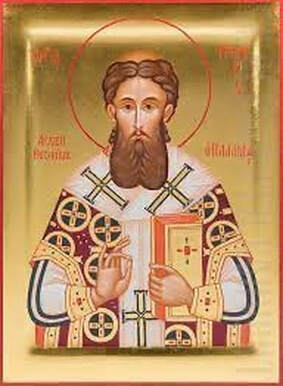
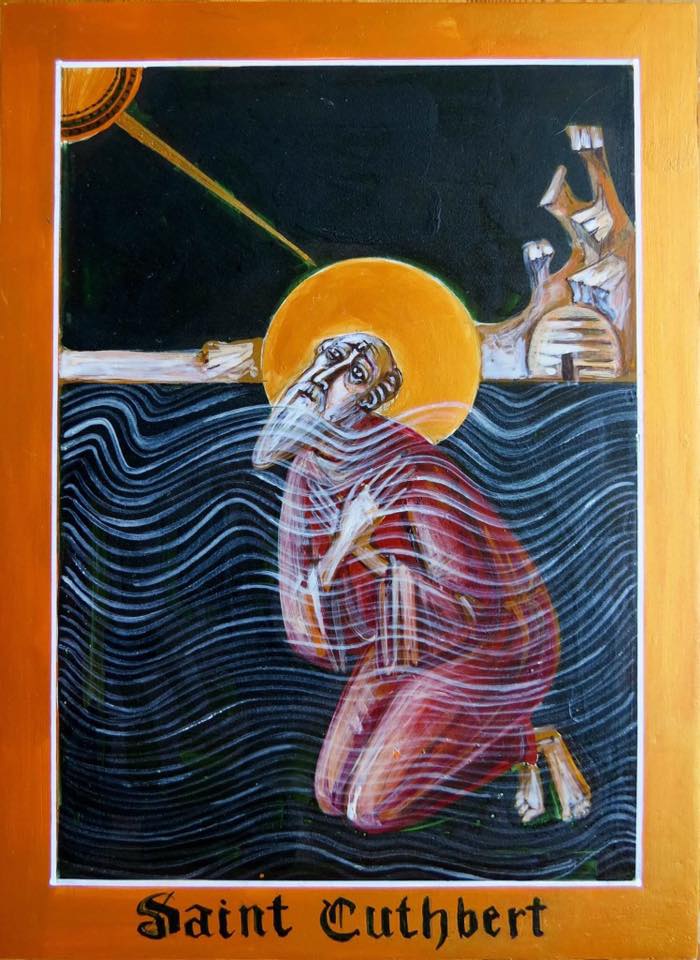
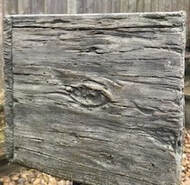
 RSS Feed
RSS Feed